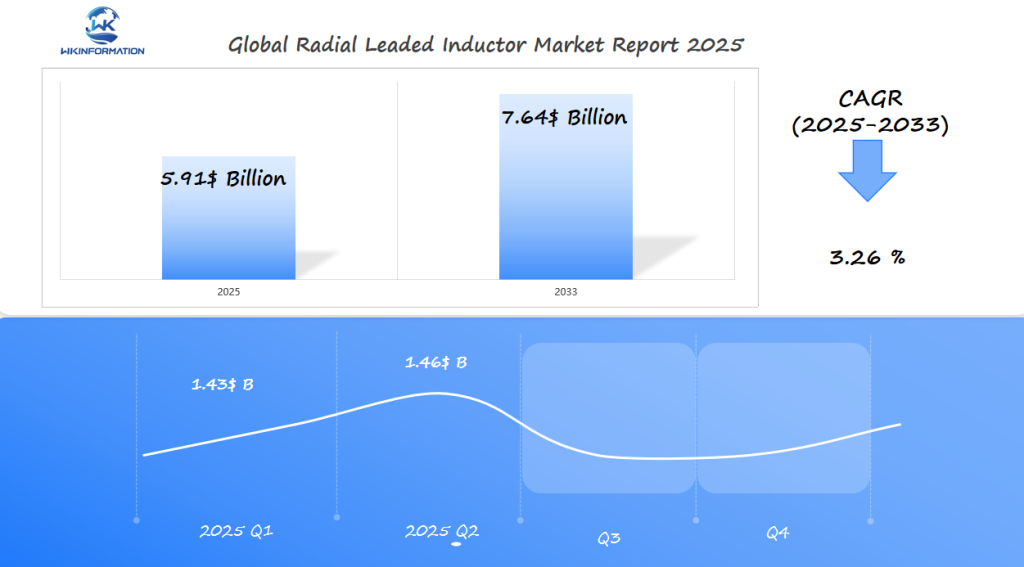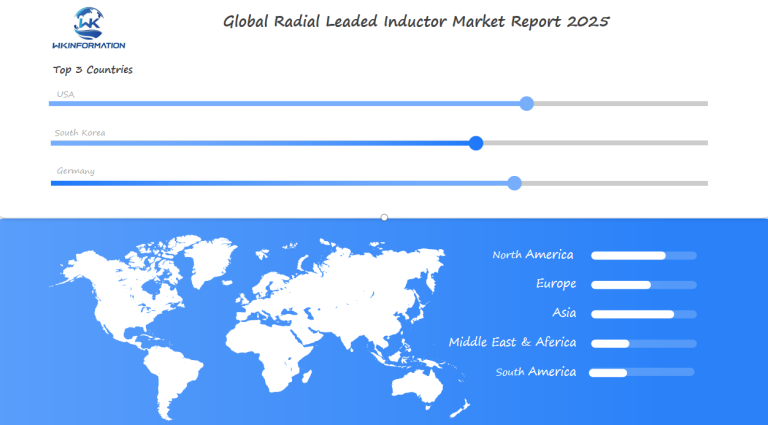Radial Leaded Inductor Market in 2025 with $5.91 Billion Growth Insights from South Korea, the US, and Germany
Explore the radial leaded inductor market growth in 2025, driven by innovations in South Korea, US, and Germany’s tech investments.
- Last Updated:
Radial Leaded Inductor Market Forecast for Q1 and Q2 of 2025
The Radial Leaded Inductor Market is valued at USD 5.91 billion in 2025 and is expected to grow at a CAGR of 3.26% from 2025 to 2033. In Q1 2025, the market is projected to generate approximately USD 1.43 billion, driven by the ongoing demand for inductors in consumer electronics, automotive, and industrial applications. By Q2 2025, the market is expected to reach around USD 1.46 billion, as industries continue to integrate advanced electronics and power management solutions.
South Korea, the US, and Germany are pivotal players in the radial leaded inductor market. South Korea remains a key market due to its strong electronics manufacturing base, particularly in consumer electronics and automotive sectors. The US, with its diverse manufacturing industries and high demand for inductive components, continues to drive market growth. Germany, a leader in industrial automation and automotive technology, also plays a crucial role in the expansion of the radial leaded inductor market.

Factors Affecting the Radial Leaded Inductor Market
In the world of radial leaded inductors, supply chain dynamics play a crucial role.
Upstream Suppliers
Upstream suppliers are responsible for providing essential materials such as ferrite cores, copper wire, and insulating materials. These components are vital for inductor production, and any disruption can significantly affect manufacturing timelines and costs.
Manufacturing Processes
Manufacturing processes also have a significant impact. The choice of techniques and technologies influences both the cost-effectiveness and quality of the final products. Precision in winding coils and assembling components is crucial to producing inductors that meet strict industry standards. Advanced manufacturing methods allow producers to enhance production capabilities, reduce waste, and optimize output.
Factors Driving Demand
On the demand side, several factors contribute to growth. The increasing need for energy-efficient solutions across automotive, telecommunications, and consumer electronics sectors drives interest in radial leaded inductors. Industries like automotive require them for EMI suppression, while telecommunications sectors use them for signal conditioning.
The interconnectedness between supply chain efficiency, manufacturing excellence, and market demand highlights the complexity of the radial leaded inductor market. Understanding these factors is essential for stakeholders looking to take advantage of emerging opportunities in this expanding industry landscape.
Key Trends Driving the Radial Leaded Inductor Market in 2025
The radial leaded inductor market is set to experience substantial growth through 2025, driven by several key trends:
1. Rising Demand for Connected Devices
Across sectors such as automotive, telecommunications, and consumer electronics, the need for connected devices is escalating. This surge is propelling the demand for radial leaded inductors, which are integral components in these technologies for their roles in energy storage and signal processing.
2. Innovations in Manufacturing Technologies
Enhanced manufacturing technologies are leading to higher performance and miniaturization of radial leaded inductors. These advancements enable manufacturers to produce more efficient and compact components, meeting the stringent requirements of modern electronic devices.
3. Growth of Consumer Electronics
The consumer electronics segment continues to expand, driving increased usage of inductors. Inductors play critical roles in energy storage and filtering applications essential for devices like smartphones, gaming consoles, and home appliances. Their ability to provide mechanical stability and reliability under varying conditions makes them indispensable in this fast-growing industry.
Technological advancements are reshaping how industries adopt these components, fostering a landscape ripe with opportunities for innovation and growth. The interplay of increased connectivity demands and cutting-edge manufacturing paves the way for significant market expansion.
Challenges and Restrictions Impacting the Radial Leaded Inductor Market
Navigating the radial leaded inductor market requires overcoming several challenges:
1. Regulatory Challenges
Manufacturers face stringent regulations across various regions. Compliance with environmental standards, such as the Restriction of Hazardous Substances (RoHS) directive in Europe, is crucial. These regulations impact material choices and manufacturing processes, often leading to increased costs and the need for continuous adaptation.
2. Supply Chain Disruptions
The global supply chain remains a critical factor. Issues such as component shortages or transportation delays can significantly affect production timelines and delivery capabilities. The ongoing semiconductor shortage exemplifies how supply chain vulnerabilities can ripple through related markets, including inductors.
3. Competitive Landscape
The radial leaded inductor market is highly competitive, with key players continually innovating to maintain their edge. Companies like Murata Manufacturing Co., Ltd., TDK Corporation, and Vishay Intertechnology are investing in research and development to enhance product performance and miniaturization efforts. Strategic partnerships and acquisitions are common strategies employed to expand market presence and diversify product offerings.
Addressing these challenges effectively is essential for stakeholders aiming to capitalize on growth opportunities within the radial leaded inductor sector.

Geopolitical Influence on Radial Leaded Inductor Market Trends
Geopolitical factors have a significant impact on the radial leaded inductor market, affecting both pricing and availability.
Impact of Trade Policies
Trade policies between major economies like the U.S., China, and the European Union influence the cost structure of these components. Tariffs, export restrictions, and import duties can result in fluctuating prices, affecting manufacturers’ margins and end-user costs.
Role of International Relations
International relations play a critical role in shaping supply chains. Collaborative agreements or strained relationships between countries determine the ease with which raw materials and finished products move across borders. For instance, favorable trade partnerships can lead to reduced production costs, enhancing profitability for manufacturers.
Geopolitical Stability in Regional Markets
In regional markets such as Asia Pacific, North America, and Europe, geopolitical stability fosters collaborations between manufacturers. These partnerships can stimulate innovation and drive down production costs through shared technology and resources.
Global Implications of Geopolitical Shifts
The global nature of the electronics industry means that even minor geopolitical shifts can have ripple effects throughout supply chains. Stakeholders need to stay informed about international developments to strategically navigate potential disruptions or leverage emerging opportunities for collaboration. This vigilance is crucial for maintaining competitive advantages in an evolving market landscape.
Segmentation of Radial Leaded Inductors by Type and Application
The world of radial leaded inductors is vast, encompassing various types and sizes suited for diverse applications. Understanding these distinctions is crucial for selecting the right component for your needs.
Types of Inductors
- Axial Inductors: Characterized by leads that run along the axis of the component body, axial inductors provide high reliability and are easy to mount on printed circuit boards (PCBs).
- Toroidal Inductors: With a doughnut-shaped core, toroidal inductors offer efficient electromagnetic interference (EMI) suppression due to their closed-loop design. These inductors are often preferred where space is a constraint.
Sizes
- 0402 and 0603 Sizes: These dimensions refer to compact surface-mount options that maintain performance while occupying minimal space on PCBs. Ideal for miniaturized electronic devices.
Applications in Electronics
Radial leaded inductors find widespread use across multiple sectors:
- Automotive: Essential for EMI suppression, they ensure smooth operation of electronic control units within vehicles.
- Telecommunications: Utilized for signal conditioning, enhancing clarity and reliability of data transmission in networks.
- Industrial Equipment: Play a critical role in power management systems, maintaining efficiency under varying load conditions.
These components serve as integral parts of modern electronics, providing reliable performance across industries. Understanding their types and applications allows you to optimize their usage effectively.
Global Insights into Radial Leaded Inductor Market Growth
The radial leaded inductor market is witnessing steady growth, driven by increasing demand in consumer electronics, automotive applications, and industrial automation. Key trends shaping the market include:
- Technological advancements in inductor materials and design for higher efficiency.
- Rising demand for energy-efficient electronics, pushing manufacturers toward compact, high-performance inductors.
- Expansion of the renewable energy sector, increasing the need for power inductors in inverters and power supplies.
- Growing adoption in automotive applications, especially with the rise of electric vehicles (EVs) and hybrid systems.

U.S. Market Insights for Radial Leaded Inductors
The United States remains a key player in the radial leaded inductor market, driven by:
- Strong presence of consumer electronics and semiconductor industries, fostering demand for high-performance inductors.
- Government initiatives promoting domestic manufacturing and R&D in advanced electronic components.
- Adoption of electric vehicles and 5G infrastructure, increasing the need for inductors in power management applications.
- Growing defense and aerospace sectors, requiring reliable, high-quality inductors for critical applications.
Opportunities and Trends in South Korea’s Radial Leaded Inductor Market
South Korea is emerging as a significant market for radial leaded inductors, driven by:
- Strong consumer electronics and semiconductor industry, led by major companies like Samsung and LG.
- Increased investment in 5G and IoT technologies, creating a demand for efficient power components.
- Rising production of electric vehicles, supporting the growth of inductor applications in automotive power systems.
- Government initiatives to boost domestic electronics manufacturing, driving further market expansion.
Germany’s Role in the Radial Leaded Inductor Market
Germany plays a crucial role in the radial leaded inductor market, primarily due to:
- Strong automotive industry, driving demand for power inductors in electric and hybrid vehicles.
- Emphasis on industrial automation and renewable energy, increasing the need for efficient power electronics.
- High investment in R&D, leading to the development of advanced inductor technologies.
- Presence of key electronics and automotive component manufacturers, supporting market stability and innovation.
Future Prospects for Radial Leaded Inductors
The future of the radial leaded inductor market is shaped by several key factors:
- Miniaturization of electronic components, pushing the demand for compact and high-efficiency inductors.
- Expansion of AI and IoT applications, requiring reliable inductors for data processing and power regulation.
- Advancements in materials science, leading to higher performance and environmentally friendly inductor solutions.
- Growth of smart grids and renewable energy, increasing the adoption of inductors in power conversion applications.
Competitive Overview in the Radial Leaded Inductor Market
-
Vishay Intertechnology – United States
-
TDK Corporation – Japan
-
Murata Manufacturing Co., Ltd. – Japan
-
Taiyo Yuden Co., Ltd. – Japan
-
AVX Corporation – United States
-
Coilcraft, Inc. – United States
-
Panasonic Corporation – Japan
Overall
| Report Metric | Details |
|---|---|
| Report Name | Global Radial Leaded Inductor Market Report |
| Base Year | 2024 |
| Segment by Type | ·Power Inductors
·RF Inductors |
| Segment by Application |
·Filtering |
| Geographies Covered | · North America (United States, Canada)
· Europe (Germany, France, UK, Italy, Russia) · Asia-Pacific (China, Japan, South Korea, Taiwan) · Southeast Asia (India) · Latin America (Mexico, Brazil) |
| Forecast units | USD million in value |
| Report coverage | Revenue and volume forecast, company share, competitive landscape, growth factors and trends |
The radial leaded inductor market is poised for growth, driven by technological advancements, increasing demand in key industries, and global expansion efforts. While North America, Europe, and Asia-Pacific remain dominant regions, emerging markets present significant opportunities. Companies investing in innovation, efficiency, and sustainability are expected to gain a competitive edge in the evolving market landscape.
Global Radial Leaded Inductor Market Report (Can Read by Free sample) – Table of Contents
Chapter 1: Radial Leaded Inductor Market Analysis Overview
- Competitive Forces Analysis (Porter’s Five Forces)
- Strategic Growth Assessment (Ansoff Matrix)
- Industry Value Chain Insights
- Regional Trends and Key Market Drivers
- Radial Leaded InductorMarket Segmentation Overview
Chapter 2: Competitive Landscape
- Global Radial Leaded Inductorplayers and Regional Insights
- Key Players and Market Share Analysis
- Sales Trends of Leading Companies
- Year-on-Year Performance Insights
- Competitive Strategies and Market Positioning
- Key Differentiators and Strategic Moves
Chapter 3: Radial Leaded Inductor Market Segmentation Analysis
- Key Data and Visual Insights
- Trends, Growth Rates, and Drivers
- Segment Dynamics and Insights
- Detailed Market Analysis by Segment
Chapter 4: Regional Market Performance
- Consumer Trends by Region
- Historical Data and Growth Forecasts
- Regional Growth Factors
- Economic, Demographic, and Technological Impacts
- Challenges and Opportunities in Key Regions
- Regional Trends and Market Shifts
- Key Cities and High-Demand Areas
Chapter 5: Radial Leaded Inductor Emerging and Untapped Markets
- Growth Potential in Secondary Regions
- Trends, Challenges, and Opportunities
Chapter 6: Product and Application Segmentation
- Product Types and Innovation Trends
- Application-Based Market Insights
Chapter 7: Radial Leaded Inductor Consumer Insights
- Demographics and Buying Behaviors
- Target Audience Profiles
Chapter 8: Key Findings and Recommendations
- Summary ofRadial Leaded Inductor Market Insights
- Actionable Recommendations for Stakeholders

Access the study in MULTIPLEFORMATS
Didn’t find what you’re looking for?
TALK TO OUR ANALYST TEAM
Need something within your budget?
NO WORRIES! WE GOT YOU COVERED!
Call us on: +1-866-739-3133
Email: infor@wkinformation.com
What are the key trends driving the radial leaded inductor market?
Key trends driving the radial leaded inductor market include the rising demand for connected devices across sectors like automotive and telecommunications, innovations in manufacturing technologies that enable higher performance and miniaturization, and the growth of consumer electronics which increases usage for energy storage and filtering applications.
What challenges does the radial leaded inductor market face?
The radial leaded inductor market faces several challenges including regulatory hurdles, supply chain disruptions affecting production and delivery timelines, and intense competition among manufacturers striving to maintain their market position.
How do geopolitical factors influence the radial leaded inductor market?
Geopolitical factors such as trade policies between major economies can significantly affect pricing and availability of radial leaded inductors globally. Additionally, international relations play a crucial role in shaping supply chains and fostering collaborations among manufacturers.
What types of applications utilize radial leaded inductors?
Radial leaded inductors are utilized across various industries including automotive for EMI suppression, telecommunications for signal conditioning, and industrial equipment for power management. The breakdown includes different types such as axial and toroidal inductors in various sizes.
What are the future prospects for the radial leaded inductor market beyond 2025?
Future prospects for the radial leaded inductor market beyond 2025 indicate continued growth trajectories driven by current trends such as Industry 4.0 initiatives that boost demand for through-hole components like inductors.

